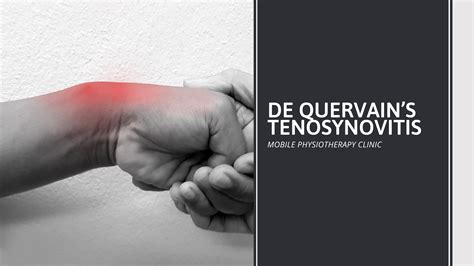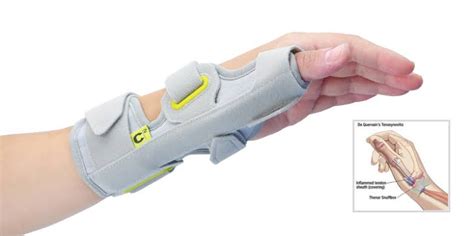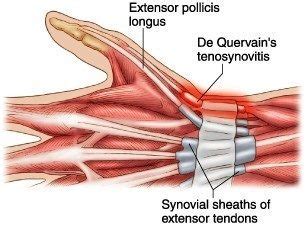Intro
Discover 7 effective ways to treat De Quervains Tenosynovitis, a common wrist condition causing pain and tenderness. Learn about non-surgical treatments, such as physical therapy and corticosteroid injections, as well as home remedies and exercises to alleviate symptoms and promote healing, reducing wrist pain and inflammation.
De Quervain's tenosynovitis is a painful condition that affects the tendons on the thumb side of your wrist. It occurs when the tendons around the base of the thumb become irritated or constricted, leading to inflammation and pain. This condition is common among people who perform repetitive activities, such as golfers, rowers, or people who frequently lift or grasp objects. If left untreated, De Quervain's tenosynovitis can lead to chronic pain, reduced mobility, and decreased grip strength. Fortunately, there are several effective ways to treat De Quervain's tenosynovitis.
Understanding De Quervain's Tenosynovitis

De Quervain's tenosynovitis is characterized by pain and tenderness on the thumb side of the wrist, which can radiate to the thumb and forearm. The pain can be sharp and stabbing, especially when grasping or gripping objects. In some cases, people with De Quervain's tenosynovitis may experience swelling, redness, or a lump on the affected area.
Causes and Risk Factors
De Quervain's tenosynovitis is often caused by repetitive strain on the tendons, which can lead to inflammation and irritation. Other risk factors include:
- Repetitive activities, such as golfing, rowing, or lifting
- Poor posture or biomechanics
- Previous injuries or trauma to the wrist or thumb
- Certain medical conditions, such as rheumatoid arthritis or gout
Treatment Options for De Quervain's Tenosynovitis

Fortunately, De Quervain's tenosynovitis can be treated with a combination of conservative and interventional methods. Here are seven ways to treat De Quervain's tenosynovitis:
1. Rest and Ice
Resting the affected area and applying ice can help reduce pain and inflammation. Avoid activities that aggravate the condition, and apply ice packs for 15-20 minutes, several times a day.
2. Physical Therapy
Physical therapy can help improve range of motion, reduce pain, and strengthen the muscles in the wrist and thumb. A physical therapist can teach you exercises and stretches to help manage the condition.
3. Bracing and Splinting
Wearing a wrist splint or brace can help immobilize the affected area and reduce pain. A splint can be custom-made or over-the-counter, and can be worn during the day or at night.
4. Corticosteroid Injections
Corticosteroid injections can help reduce inflammation and relieve pain. These injections are typically administered by a healthcare professional and can be repeated if necessary.
5. Platelet-Rich Plasma (PRP) Therapy
PRP therapy involves injecting platelet-rich plasma (PRP) into the affected area. PRP is derived from the patient's own blood and contains growth factors that can help stimulate healing.
6. Surgical Release
In severe cases of De Quervain's tenosynovitis, surgical release may be necessary. This involves releasing the constricted tendon sheath to reduce pressure on the tendons.
7. Alternative Therapies
Alternative therapies, such as acupuncture, massage, or chiropractic care, can help manage pain and reduce inflammation. These therapies can be used in conjunction with other treatment methods.
Preventing De Quervain's Tenosynovitis

Preventing De Quervain's tenosynovitis requires making lifestyle changes and taking steps to reduce repetitive strain on the tendons. Here are some tips to prevent De Quervain's tenosynovitis:
- Take regular breaks to stretch and rest your hands and wrists
- Maintain good posture and biomechanics
- Avoid repetitive activities or take steps to modify your technique
- Wear a wrist splint or brace during activities that aggravate the condition
- Stay hydrated and maintain a healthy diet to reduce inflammation
Conclusion
De Quervain's tenosynovitis is a painful condition that can be effectively treated with a combination of conservative and interventional methods. By understanding the causes and risk factors, and taking steps to prevent the condition, you can reduce your risk of developing De Quervain's tenosynovitis. If you're experiencing symptoms of De Quervain's tenosynovitis, consult with a healthcare professional to determine the best course of treatment.
What is De Quervain's tenosynovitis?
+De Quervain's tenosynovitis is a painful condition that affects the tendons on the thumb side of the wrist.
What are the symptoms of De Quervain's tenosynovitis?
+Symptoms of De Quervain's tenosynovitis include pain and tenderness on the thumb side of the wrist, swelling, redness, and a lump on the affected area.
How is De Quervain's tenosynovitis treated?
+De Quervain's tenosynovitis can be treated with a combination of conservative and interventional methods, including rest and ice, physical therapy, bracing and splinting, corticosteroid injections, platelet-rich plasma (PRP) therapy, and surgical release.
